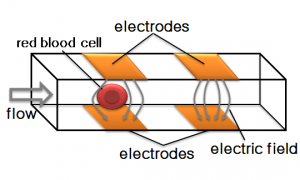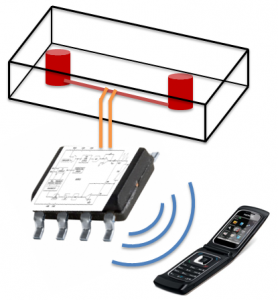A Malaria-diagnostic System Based on Electric Impedance Spectroscopy
Malaria kills about a million people worldwide a year. The parasitic disease prevails mainly in Africa, India, and Brazil; it is life-threatening if not treated quickly [1]. In Africa, where the majority of casualties occur, medical care is lacking and field-diagnostic devices are in great demand. Developing countries with emerging markets and large populations have great demands for low-cost health care and malaria control systems.
Various studied have been conducted on the effects of malaria parasites in human red blood cells (RBCs). The malaria parasite changes deformability of an RBC and makes it stiff. Additionally, it reduces hemoglobin concentration by converting it to hemozoin. As a consequence, the dielectric coefficient and refractive index map of individual cells change [2]. However, diagnostic techniques utilizing those effects may require long diagnosis time and/or expensive fluorescent microscopes.
We are developing a malaria-diagnostic system based on electric impedance spectroscopy. Instead of mechanical or optical properties of cells, our interest focuses on the electrical property of RBC and changes that occur after infection [3]. Electric impedance spectroscopy allows measuring the electric impedance of individual RBCs in a flowing channel with high throughput [4], so that the device can detect malaria-infected cells from whole blood in a short time. A low-power BioMEMS-IC hybrid chip can also play the role of a front-end device in a wireless diagnostic system.
- Figure 1: Microfluidic channel for electric impedance spectroscopy.
- Figure 2: Malaria-diagnostic BioMEMS-IC hybrid system. From IC, processed impedance data is sent out.
References
- World Health Organization Staff, World Malaria Report 2009, World Health Organization, Geneva, Switzerland, 2009. [↩]
- Y. Park, “Refractive index maps and membrane dynamics of human red blood cells parasitized by Plasmodium falciparum,” PNAS, vol. 105, pp. 13730-13735, Sep. 2008. [↩]
- C. Ribaut, “Electrochemical impedance spectroscopy to study physiological changes affecting the red blood cell after invasion by malaria parasites,” Biosensors and Bioelectronics, vol. 24, pp. 2721-2725, 2009. [↩]
- T. Sun and H. Morgan, “Single-cell microfluidic impedance cytometry: a review,” Microfluid Nanofluid, vol. 8, pp. 423-443, 2010. [↩]

